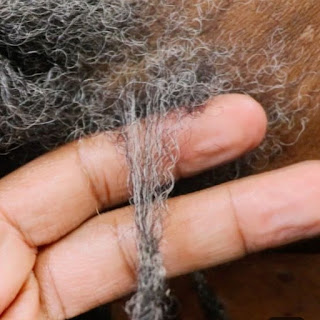TO INTERLOCK OR NOT
The decision to interlock or not has posed a sensitive debate in the loc community.
The aim of this article is to throw more light into the much spoken dangers of interlocking and the appropriate solutions around it and therefore help you choose if it is appropriate for you to adopt in accordance to your preference.
Interlocking is a method of maintaining new growth with the use of an interlocking tool or a latch hook. This can be done in 3 rotations which are the
*2 point rotation
*3 point rotation
*4 point rotation
1⃣ It has been said that one of the major dangers of interlocking is that it leads to thinning of locs. But does it really do that?
I would love to classify thinning caused by interlocking into two
💚Real (actual) thinning: This type of thinning can only really occur due to frequent interlocking of new growth. How?
Interlocking is done between 6-8weeks time frame of last interlock,ideally 8 weeks because by then enough new growth have sprouted. When it is done in a time frame less than what was mentioned regularly,it will ultimately lead to thinning.
👉Solution:
This type of thinning can be avoided by extending interlocking sessions to 8 weeks and later.
💚 Virtual (Illusion) thinning: Thinning that seems to occur as a result of interlocking but it is not real. It can be envisioned as an illusion. This type of thinning occurs when a person previously palmrolling switches to interlocking as a method of maintenance. This switch up creates an illusion of thinner locs because interlock provides a compact/condensed locs in relation to palmrolling.
This type of illusion thinning can be seen in a person who has braidlocs compared to someone who start his/her locs with two strand twists. So bear this in mind that interlocking is similar to braiding because they both hold your hair in compressed form and do not necessarily thin your locs.
👉Solution:
When starting out locks,be consistent in your choice of how to maintenance to avoid these irregularities in the consistency of your loc size.
If you choose to interlock or palmroll, fine stick with. Switching back and forth will create a line of demarcation between these two areas that produces a kink/bend.
2⃣ Another complication that could arise from interlocking is severe headache from interlocking too tight or close to scalp of one's head.
👉Solution:
Do not interlock too close to your scalp,leave some tiny amount of loose hair so that that portion allows for flexibility of your locs.
3⃣ Another yet complication of interlocking, you should be aware of, is the the patterns the interlock method leave. As mentioned earlier,interlocking is similar to having braids which have patterns that are hard to disappear. It is not much of an alarm if your cool with it as it tends to get covered up with frizz overtime.
👉Solution:
Do not attempt to interlock by yourself if you are not properly educated on it.
Do not interlock through the same place twice,it leaves a two thong separation on your scalp which divides your locs into two.
4⃣ Another problem that could arise from interlocking is knowing what rotation to choose. While it is said that a 2 point rotation offer a rather thicker locs compared to the 4 point rotation. It should also be noted that the 4 point rotation gives a rounder loc compared to an almost flat look that the 2 point rotation offers.
👉Solution:
Bear the above features in minding while choosing your preference. Also note that alternatively,you could choose a 3 point rotation which is a middle ground feature of the 2point and 4 point rotations.
🆕 Who should interlock??
Interlocking is a viable method for;
💚Those who have an active lifestyle or workout a lot.
💚Those on sisterlocs/microlocs.
💚Those who started braidlocs on lengthy hair (to avoid disparities between the braided and palmrolled locs size).
💚Those whose loctician live far away and travel miles for an appointment.
💚Those who swim often such as athlete swimmers.
💚Those whose hair has a lot of slippage and won't loc.
💚Those who don't want to retwist their hair often.
The aim of this article is to throw more light into the much spoken dangers of interlocking and the appropriate solutions around it and therefore help you choose if it is appropriate for you to adopt in accordance to your preference.
Interlocking is a method of maintaining new growth with the use of an interlocking tool or a latch hook. This can be done in 3 rotations which are the
*2 point rotation
*3 point rotation
*4 point rotation
1⃣ It has been said that one of the major dangers of interlocking is that it leads to thinning of locs. But does it really do that?
I would love to classify thinning caused by interlocking into two
💚Real (actual) thinning: This type of thinning can only really occur due to frequent interlocking of new growth. How?
Interlocking is done between 6-8weeks time frame of last interlock,ideally 8 weeks because by then enough new growth have sprouted. When it is done in a time frame less than what was mentioned regularly,it will ultimately lead to thinning.
👉Solution:
This type of thinning can be avoided by extending interlocking sessions to 8 weeks and later.
💚 Virtual (Illusion) thinning: Thinning that seems to occur as a result of interlocking but it is not real. It can be envisioned as an illusion. This type of thinning occurs when a person previously palmrolling switches to interlocking as a method of maintenance. This switch up creates an illusion of thinner locs because interlock provides a compact/condensed locs in relation to palmrolling.
This type of illusion thinning can be seen in a person who has braidlocs compared to someone who start his/her locs with two strand twists. So bear this in mind that interlocking is similar to braiding because they both hold your hair in compressed form and do not necessarily thin your locs.
👉Solution:
When starting out locks,be consistent in your choice of how to maintenance to avoid these irregularities in the consistency of your loc size.
If you choose to interlock or palmroll, fine stick with. Switching back and forth will create a line of demarcation between these two areas that produces a kink/bend.
2⃣ Another complication that could arise from interlocking is severe headache from interlocking too tight or close to scalp of one's head.
👉Solution:
Do not interlock too close to your scalp,leave some tiny amount of loose hair so that that portion allows for flexibility of your locs.
3⃣ Another yet complication of interlocking, you should be aware of, is the the patterns the interlock method leave. As mentioned earlier,interlocking is similar to having braids which have patterns that are hard to disappear. It is not much of an alarm if your cool with it as it tends to get covered up with frizz overtime.
👉Solution:
Do not attempt to interlock by yourself if you are not properly educated on it.
Do not interlock through the same place twice,it leaves a two thong separation on your scalp which divides your locs into two.
4⃣ Another problem that could arise from interlocking is knowing what rotation to choose. While it is said that a 2 point rotation offer a rather thicker locs compared to the 4 point rotation. It should also be noted that the 4 point rotation gives a rounder loc compared to an almost flat look that the 2 point rotation offers.
👉Solution:
Bear the above features in minding while choosing your preference. Also note that alternatively,you could choose a 3 point rotation which is a middle ground feature of the 2point and 4 point rotations.
🆕 Who should interlock??
Interlocking is a viable method for;
💚Those who have an active lifestyle or workout a lot.
💚Those on sisterlocs/microlocs.
💚Those who started braidlocs on lengthy hair (to avoid disparities between the braided and palmrolled locs size).
💚Those whose loctician live far away and travel miles for an appointment.
💚Those who swim often such as athlete swimmers.
💚Those whose hair has a lot of slippage and won't loc.
💚Those who don't want to retwist their hair often.








What happens when a 4 point rotation is changed to a 2 point rotation. I moved far from my loctitian and the lady I found did a 2 point rotation. I’m afraid my locks will be affected. Please help
ReplyDeleteI have the same question. Can I go from a 3 point interlocking method to a 4 point?
ReplyDelete